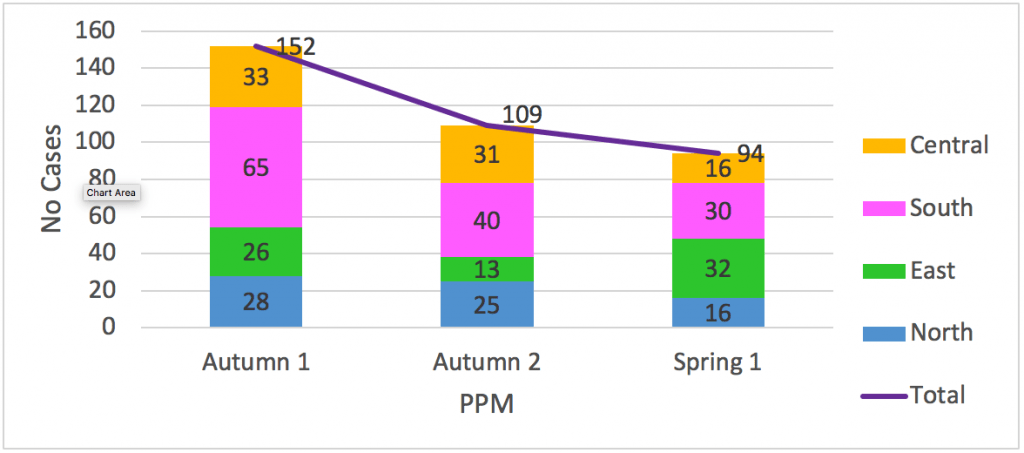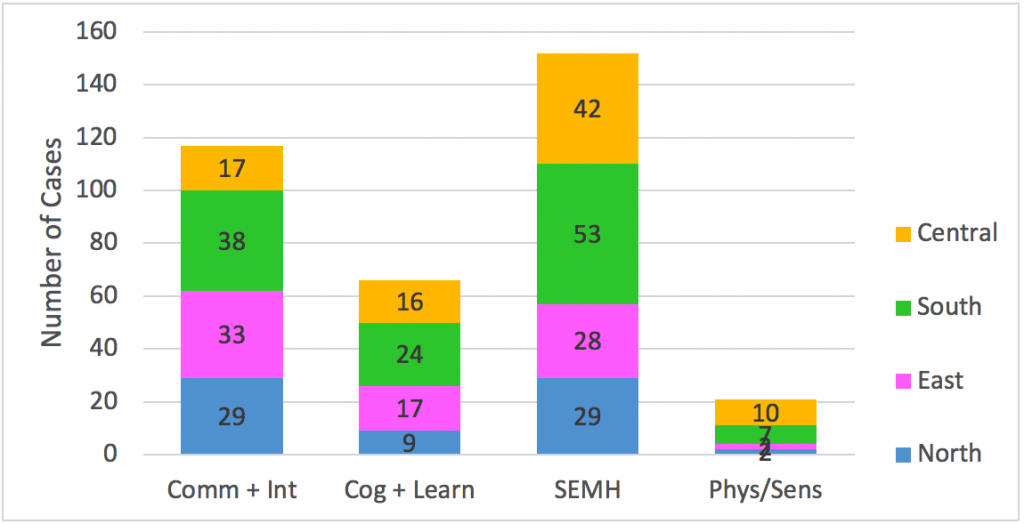Reflections on Pyramid Planning Meetings one year on

One year ago, Doncaster EPS made the decision to change our service delivery model.
We moved from individual planning meetings twice per year with each school SENDCO, to multi-agency meetings each half term with all SENDCOs within a secondary school pyramid (Holly wrote about this in the blog ‘Pyramid Planning Meetings‘). Since then, we have led 15 PPMs, where 385 individual cases have been discussed in total.
We have now had the opportunity to reflect and analyse the impact of this change, through SENDCO views of the new consultation model, quantitative data analysis of cases discussed at PPMs, and EP reflections on their facilitation of the PPMs. These are summarised in themes below with some implications for the future discussed.
Logistics and structure of Pyramid Planning Meetings
As figure one highlights, attendance by schools to PPMs was inconsistent throughout the year. The highest average attendance was for the first PPM in September/October (Autumn 1), with a general downward trend in attendance across all localities, apart from the anomalous Spring 2 attendance in the East locality.

This implies that having a PPM each half term may be too much for SENDCOs to attend, particularly with feedback from them suggesting that they had found it difficult to attend three-hour meetings during the school day.
As expected, the first PPM in the Autumn 1 half term yielded the discussion of most cases (152) – see figure 2. Further PPMs in the Autumn 2 and Spring 1 half terms demonstrated a downward trend in number of cases discussed (109 and 94 respectively), however this may represent lower attendance by schools rather than reduced need to discuss individual cases.

SENDCOs appreciated that the PPM format was more time-efficient for EPs and for them to access support from a range of professionals at once, rather than having to attend multiple meetings with each professional separately. This also ensured the most appropriate services were involved in supporting each case. SENDCOs reported that having a consistent EP facilitating PPMs and the presence of other professionals were the two most useful features of PPMs
Purpose, roles and relationships
Some key findings about the purpose of the PPM meetings are:
- All EPs identified the purpose of PPMs as collaborative problem solving whereas only 46% of SENCOs identified the purpose as a collaborative multi-agency approach to supporting children and young people.
- 41% of SENDCOs identified the purpose of a PPM as gaining strategies to support students, which some EPs reflected that they sometimes left PPMs not fully aware of what outcomes SENDCOs had taken away from the meeting.
- 56.5% of SENDCOs also felt it would be beneficial if they were more informed of the purpose of a PPM.
This suggests that the EP service needs to ensure the purpose of PPMs is communicated clearly and meets the needs of the schools.
Analysing cases by need
SEMH was identified as primary need in the majority of cases (40%), followed by Communication and Interaction needs (30.6%) – see figure 3.

Interestingly, this did not correlate with EHCPs issued in Doncaster this academic year – only 16% of EHCPs identified primary need as SEMH, whilst 50% of EHCPs recorded SLCN or ASD. When analysing this data at a locality level, variation between localities emerged, for example, SEMH was the highest primary need identified in cases discussed in the Central and South localities, however communication and interaction needs were highest in the North and East localities.
This has implications for the EPs working in these localities to increase their understanding of need in the communities they support.
Outcomes and effectiveness
SENDCOs identified four main reasons for bringing cases to PPMs:
- advice
- explanations
- specialist provision
- raising awareness.
The majority of cases brought to PPMS were seeking advice for what to do next (93%). Of these participants, 86% were satisfied with the support offered (rating good or excellent).
SENDCOs reported the most important outcomes they aimed to gain from attending a PPM were further Educational Psychologist involvement or guidance on support strategies and unpicking behaviour (both reported by 39.1% of participants).
Four out of five SENDCOs felt that they had gained new knowledge or understanding from attending PPMS, with 45% of these identifying strategies they had implemented as a result of attending. A quarter of respondents also identified that they had increased awareness of support offered by other professionals and how to access this.
SENDCOs also revealed barriers to being able to complete the outcomes identified in PPMs, including:
- Not being in a position to create change, e.g. not being a member of the Senior Leadership Team,
- Lack of support staff and other resources,
- Lack of support from the LA/other services
Improvements
Consistent with the pilot study, half of SENDCOs felt that timings of the PMMs were problematic, identifying that a 3 hour meeting once per half term during the school day was too much time away from other teaching responsibilities. Secondary schools also felt that the time given to each school to discuss cases was unrepresentative of need, for example the same amount of time was allocated for secondary and primary schools to discuss cases, even though secondaries have significantly more students and there are more primary schools in each PPM. As a result of this, we are considering delivering secondary school specific PPMs once per term for the secondaries in each locality, which we hope will meet the needs identified.
SENDCOs and EPs also identified the opportunity for the purpose of PPMs to adapt over time to meet the needs of each pyramid, for example providing training specific to each pyramid’s emerging needs.
Overall, feedback from SENDCOs and EPs has been largely positive and, with the significant progress we have made so far in the journey to establish PPMs, we look forward to seeing what further opportunities they present for collaborative work between schools, the EP service and other multi-agency professionals in the future.




